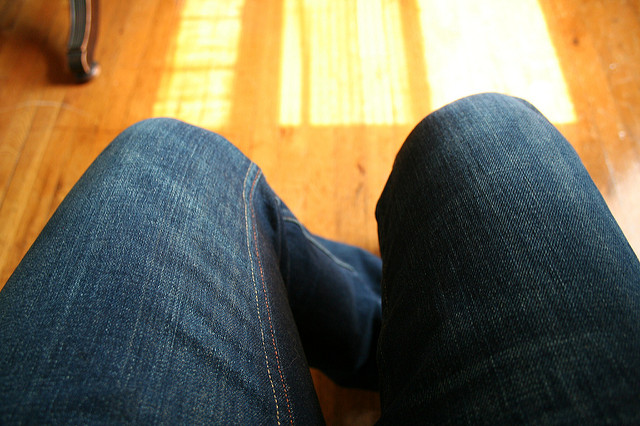One of the reasons why denim jeans remain the world’s most popular choice of pants is because they are available in so many different fits. Regardless of your personal style, chances are there’s a pair of denim jeans with your name on it. But first you’ll need to determine which fit is best suited for your needs. While you may have a general understanding of some denim fits, others will probably surprise you. So today we’re going to take a closer look at both the common and not-so-common jean fits, revealing their unique characteristics.
Skinny
Featuring a slim leg that may or may not narrow, skinny legs offer a unique style that’s simply not found in other fits. They are often worn by slim men and women who want to elongate their appearance. Skinny jeans are characterized by a unique design in which the legs remain, well, skinny, often providing just enough room for the legs and nothing more. This fit has both advantages and disadvantages. On the plus side, skinny jeans offer a clean, modern look that’s easy to match with other clothes and garments. If you plan on staying active and moving around, however, the narrow leg opening may create discomfort — something that many active individuals want to avoid.
Tapered Jeans
A less-common fit is tapered. If boot-cut jeans are located on one end of the denim spectrum, tapered fit are located on the opposite end. They typically become more narrow through the legs towards the ankle, although not necessarily to the degree of skinny jeans. Nonetheless, many designers and individuals classify tapered jeans as a type of skinny jeans, simply because the characteristics of the two are similar. So if you don’t like skinny jeans, you probably won’t like tapered jeans — and vise-versa.
Straight-Leg
Not to be confused with skinny fit, straight-leg jeans look similar to their skinny counterpart. The one difference, however, is that straight-leg jeans fit more tightly through the thigh but wider through the leg. Straight-leg jeans still narrow as the leg transitions into the ankle, which is a distinguishable characteristic of this style. Many men and women who dislike skinny jeans actually like straight-leg for this reason. They look similar to skinny jeans but with a lower degree of narrowing.
Whether it’s skinny, straight-leg or tapered, these three fit styles are best worn with sneakers, Oxfords or similar traditional shoes instead of boots. The narrow leg and ankle prevents the bottom from going over the top of boots. So if you’re planning to wear boots, avoid these three fit styles and choose a different one, such as boot-cut.
Boot-Cut
Boot-cut jeans are exactly what they sound like: jeans that are designed specifically for use with boots. Exact measurements and fit will vary from manufacturer to manufacturer, but you can expect a pair of boot-cut jeans to contain a relatively wide opening through the leg with an equally large, if not larger, opening at the ankle. This large/wide ankle opening allows the wearer to place the bottom of his or her jeans over the top of their boots.
Stretch Jeans
We can’t talk about the different jean fits without mentioning stretch jeans. As the name suggests, stretch jeans are characterized by a greater level of elasticity than traditional, standard jeans. While most jeans are made with 100% denim, stretch jeans typically contain some type of elastic material, such as polyester or Spandex, to create a higher level of elasticity. And when jeans are more elastic, they can be stretched and pulled without fear of breaking or otherwise damaging the fabric.
If you’re interested in stretch denim jeans, click here to browse through our wide selection of this popular style.
Cigarette-Bottom Jeans
What in the world are cigarette-bottom jeans? These jeans also fit snug through the leg and thighs, ending with a narrow opening at the ankle. With that said, cigarette-bottom jeans differ from other styles in the sense that the ankle is typically shorter. Instead of stopping around the feet, for instance, they stop a few inches up the ankle. This is actually preferred by some women, as it draws attention to their feet and shoes. But if you want to keep the focus on your face/body, skip the cigarette-bottom jeans and choose a different fit style.
Anti-Fit Jeans
Yep, you read that correctly: there’s a particular fit style for jeans that’s called “anti-fit.” Anti-fit jeans are characterized by a long rise, a medium opening through the legs, and a narrow ankle opening of just 36cm. It’s a unique combination that stands out from other styles. Most jeans with a narrow opening at the ankle are also narrow through the legs and thighs, but not anti-fit. They have a medium leg opening with a more narrow ankle opening.
Flare Jeans
Last but not last, flare jeans have a medium opening through the legs but flare wide at the ankle (hence the name). They were a popular choice back in the 1970s and 80s, after which the demand for this unique style began to decline. But there’s been a growing popularity surrounding flare jeans in recent years, with men and women alike seeking to wear them.
Now that you know about the different fit styles, you might be wondering which one is right for you. Well, there’s really no easy answer to this question, as it depends on a number of factors, such as your personal style, the occasion for which it is worn, your choice of shirt/shoes, etc. With that said, it’s best to consider when and how you’ll be wearing the jeans, and then you can choose the most appropriate fit style. For semi-formal occasions that call for business casual attire, for instance, perhaps a pair of straight-leg jeans will work best. But if you’re going out for dinner and drinks with friends, maybe you should choose a style that emphasizes your feet and shoes, such as cigarette-bottom. If you can’t seem to choose a fit, try adding several different fits to your wardrobe. The more jeans you have , the more choices you’ll have available when getting ready in the morning.












